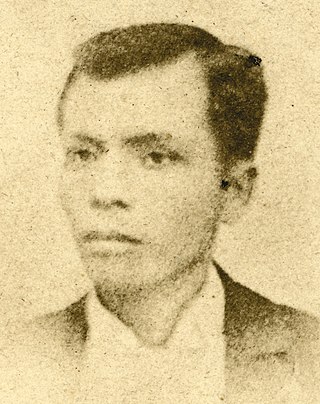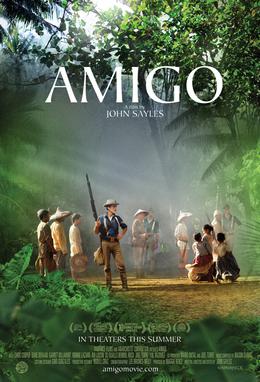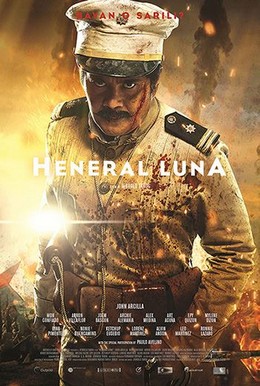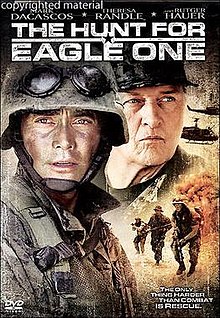
Andrés Bonifacio y de Castro was a Filipino revolutionary leader. He is often called "The Father of the Philippine Revolution", and considered a national hero of the Philippines.

The Philippine–American War, known alternatively as the Philippine Insurrection, Filipino–American War, or Tagalog Insurgency, was fought between the First Philippine Republic and the United States from February 4, 1899, until July 2, 1902. Tensions arose after the United States annexed the Philippines under the Treaty of Paris at the conclusion of the Spanish–American War rather than acknowledging the Philippines' declaration of independence. The war can be seen as a continuation of the Philippine struggle for independence that began in 1896 with the Philippine Revolution against Spanish rule.

The People Power Revolution, also known as the EDSA Revolution or the February Revolution, was a series of popular demonstrations in the Philippines, mostly in Metro Manila, from February 22 to 25, 1986. There was a sustained campaign of civil resistance against regime violence and electoral fraud. The nonviolent revolution led to the departure of Ferdinand Marcos, the end of his 20-year dictatorship and the restoration of democracy in the Philippines.

Theresa E. Randle is an American actress. She has appeared in films such as Malcolm X (1992), Beverly Hills Cop III (1994), Space Jam (1996), Spawn (1997) and the Bad Boys franchise (1995–2020).
Cirio Hermoso Santiago was a Filipino film producer, director and writer. He used the screen names Cirio Santiago, Cirio H. Santiago, Leonardo Hermoso, and Leonard Hermes.

The history of the Philippines from 1898 to 1946 is known as the American colonial period, and began with the outbreak of the Spanish–American War in April 1898, when the Philippines was still a colony of the Spanish East Indies, and concluded when the United States formally recognized the independence of the Republic of the Philippines on July 4, 1946.
On July 27, 2003, the Oakwood mutiny was staged by a group of about 300 armed defectors from the Armed Forces of the Philippines (AFP) and the Philippine National Police (PNP) led by Army Capt. Gerardo Gambala and Navy Lt. Senior Grade Antonio Trillanes IV against the Arroyo administration. The group forcibly seized and occupied Oakwood Premier in Glorietta, Makati for almost 20 hours. They expressed grievances against the government's supervision of the military, and demanded the resignation of Defense Secretary Angelo Reyes, PNP Director General Hermogenes Ebdane, and AFP Chief of Intelligence Service Victor Corpus; They also aired their grievances against the military establishment and anomalies on the AFP. The mutiny was covered heavily by the local press, who dubbed the group as "Magdalo" in reference to their insignia, which alludes to the Magdalo faction during the Philippine Revolution, despite the group officially calling themselves "Bagong Katipuneros". The mutiny ended after the government successfully negotiated with the group. Several prominent participants of the mutiny, including Trillanes and Gambala, were later charged.
The most serious attempted coup d'état against the government of Philippine President Corazon Aquino was staged beginning December 1, 1989, by members of the Armed Forces of the Philippines belonging to the Reform the Armed Forces Movement (RAM) and soldiers loyal to former President Ferdinand Marcos. Metro Manila was shaken by this Christmas-time coup, which almost seized Malacañang Palace. It was completely defeated by the Philippine government by December 9, 1989.

Highway Dragnet is a 1954 American film noir B film crime film directed by Nathan Juran from a story by U.S. Andersen and Roger Corman. The film stars Richard Conte, Joan Bennett and Wanda Hendrix. It was Roger Corman's first feature film credit. Corman also worked as an associate producer.

Amigo is a 2010 drama film written and directed by John Sayles. The film takes place in the Philippines in 1900 during the Philippine–American War.

El Presidente: General Emilio Aguinaldo Story and the First Philippine Republic, or simply El Presidente, is a 2012 Filipino biographical film written and directed by Mark Meily about the life of General Emilio Aguinaldo, the first president of the Philippine Republic. The film stars Jeorge "E.R." Ejercito Estregan in the title role, along with Nora Aunor, Christopher de Leon, Cristine Reyes, and Cesar Montano.

The Battle of Imus, or the siege of Imus, was the first major battle of the Philippine revolution against the Spanish colonial government in the province of Cavite. It was fought between September 1–3, 1896 at Imus, Cavite province in the Philippines, right after Bonifacio's attack on the gunpowder magazine at the Battle of San Juan del Monte in Manila.
The People Power Revolution was a series of popular demonstrations in the Philippines that began in 1983 and culminated in 1986. The methods used amounted to a sustained campaign of civil resistance against regime violence and electoral fraud. This case of nonviolent revolution led to the toppling of dictator Ferdinand Marcos and the restoration of the country's democracy.

The Hunt for Eagle One: Crash Point is a 2006 direct-to-video war film directed by Brian Clyde and produced by Roger Corman, starring Mark Dacascos, Theresa Randle, Jeff Fahey, Joe Suba, and Zach McGowan; Rutger Hauer did not return. The sequel to The Hunt for Eagle One, the story again takes place during Operation Enduring Freedom in the Philippines,

Heneral Luna is a 2015 Filipino epic war film starring John Arcilla as the titular character Antonio Luna who led the Philippine Revolutionary Army during the early phases of the Philippine–American War. Directed by Jerrold Tarog and produced by Artikulo Uno Productions, the film received critical acclaim from critics, praising its cinematography, writing, acting and plot. The film was selected as the Philippine entry for the Best Foreign Language Film at the 88th Academy Awards but it was not nominated.

Roger Corman's Operation Rogue is a 2014 direct-to-video action film and, although not the sequel to Corman's The Hunt for Eagle One, and The Hunt for Eagle One: Crash Point, has many similarities to them. Following the same format of the earlier films, the story again takes place in the Philippines and involves international terrorism.

Mistah is a 1994 Philippine action film directed by Ricardo "Bebong" Osorio. The film stars Robin Padilla, Roi Vinzon, BB Gandanghari, Rommel Padilla and Ana Roces. Mistah is a military slang meaning "schoolmate" within the Philippine Military Academy.
The Siege at Hotel Delfino in Tuguegarao, Cagayan in the Philippines, took place on March 4, 1990. A private army estimated at 300 men seized the hotel under the command of suspended Cagayan governor Rodolfo "Agi" Aguinaldo, a fierce critic of the administration of President Corazon Aquino and the Communist insurgency in the Philippines. The incident was an offshoot of the 1989 Philippine coup d'état attempt that Aguinaldo publicly supported, which prompted his suspension and arrest. The standoff ended violently after several hours, leaving 14 people dead, including a general who tried to arrest him.

Goyo: The Boy General, or simply Goyo, is a 2018 Filipino epic war film starring Paulo Avelino as the titular "Boy General", Gregorio del Pilar, who fought and died at the Battle of Tirad Pass during the Philippine–American War. It was written, directed, edited, and scored by Jerrold Tarog, and is a sequel to the 2015 film Heneral Luna, which chronicled Antonio Luna's life. Additional members of the ensemble cast include Carlo Aquino, Mon Confiado, Epy Quizon, Gwen Zamora, Empress Schuck, Alvin Anson, and Rafa Siguion-Reyna. It was released on September 5, 2018.

Tirad Pass: The Last Stand of Gen. Gregorio del Pilar is a 1996 Philippine biographical epic film directed by Carlo J. Caparas and starring Romnick Sarmenta as the titular Gregorio del Pilar, one of the youngest Filipino generals during the Philippine–American War, who died in the Battle of Tirad Pass.















